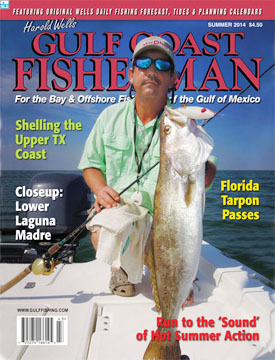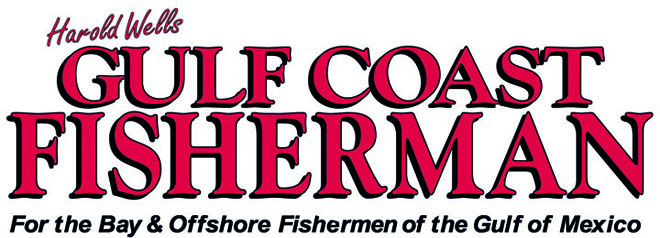
The Saltwater Magazine for Gulf Coast Fishing!
FISHING FORECASTS
| FISHING CALENDARS | ARTICLES | ADVERTISE
| SUBSCRIBE
Advertise
with GCF!
Search Gulf Coast Fisherman's
Web Site
Past articles, specific
places or fish, etc.

Summer Angling Options
in the Lower Laguna Madre
by Capt. Danno Wise
Summer 2014
Get the full digital version of the Summer 2014 issue Now!
Single Copy Digital Issue: $3.95
| CURRENT
MOON lunar phases |
Summer is one of the most popular times to hit the coast in search of inshore species. From the Florida Keys to Deep South Texas, fishermen will be taking to bays, inlets and beachfronts, casting to speckled trout, redfish, flounder and a host of other species, depending on their geographic location. And, without a doubt, the bookends to the Gulf Coastal Curve offer the most variety of species. On the Western Gulf, the Lower Laguna Madre is as far south as American anglers can go before crossing the Mexican border. For fishermen looking for inshore variety, it is certainly worth the trip - especially during the summer months.
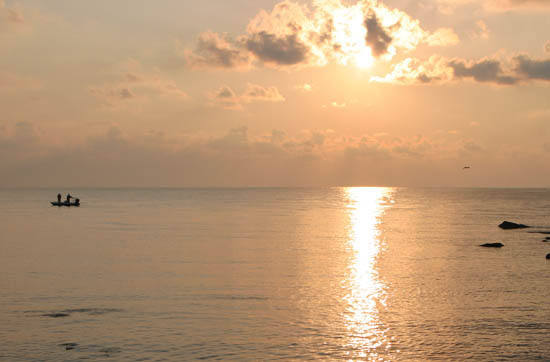
The Lower Laguna Madre
For all practical purposes the Lower Laguna Madre extends from the Brownsville Ship Channel north to the Land Cut which connects the Lower Laguna with the Upper Laguna. South Bay, which lies below the Brownsville Ship Channel, is technically a separate body of water, but most anglers view it as an extension of the Lower Laguna. If there was one word to describe the Lower Laguna as a general overview, it would be "shallow." The bay averages less than 3 feet deep. Additionally, it is hypersaline, due largely to a lack of incoming rivers and Gulf passes. The only river to dump directly into the Lower Laguna is the Arroyo Colorado, which enters roughly halfway between Port Isabel and Port Mansfield. And, there are but two Gulf passes - the Brazos Santiago Pass, a natural pass at the southern end of South Padre Island, and the East Cut, a manmade pass directly across from Port Mansfield.
The Lower Laguna Madre is oriented roughly north and south, with the Intracoastal Waterway bisecting the length of the bay. Anglers throughout the Lower Laguna will refer to "east side" or "west side" in relation to the ICW. Throughout the Lower Laguna, grass is the main structural feature. The biggest difference between the two sides is the primary bottom composition - mostly sand bottom on the east side and mud bottom on the west. Of course, some of each type, as well as various blends, are found in portions of both the east and west sides, but those are the materials most commonly found on the bottom of the two halves of the Lower Laguna. Additionally, besides the massive ICW, the Lower Laguna is criss-crossed with dozens of old service and oil field channels, and offer fish a few deeper "holes" to hide in when temperatures get either too hot or cold.
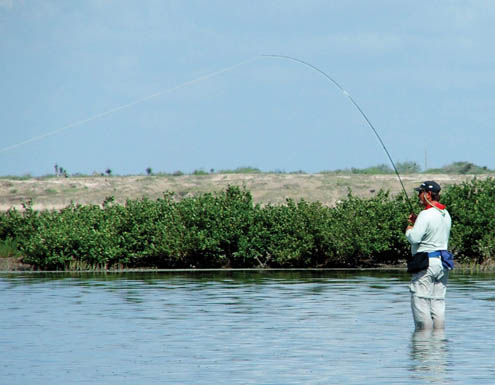 Variety is the
Spice of the LLM
Variety is the
Spice of the LLM
There are many attractive elements to the Lower Laguna Madre, but none really beat its diverse amount of sport fish species. For anglers in or heading to the Lower Laguna Madre area, Memorial Day signals the beginning of an incredible couple months of fishing opportunities. Throughout the summer months, inshore and nearshore anglers can realistically expect to hookup with everything from speckled trout to tarpon to kingfish.
While the species are available throughout the length of the LLM during the summer, for fishermen heading to Deep South Texas for a summer fishing vacation, the biggest choice may be which end of the LLM fits their individual vacation styles. Port Isabel and South Padre Island, located on the southernmost end of the Lower Laguna, afford visiting fishermen numerous restaurant and hotel choices, as well as plenty of attractions not to mention a bevy of bay side bars and clubs. Port Mansfield, situated on the northern edge of the Lower Laguna, stands in stark contrast to South Padre. With a population in the hundreds as in about 300 Port Mansfield is 'quaint,' to say the least. However, it is the perfect spot for anglers looking to focus on fishing and enjoy a little solitude. And, since it is surrounded by thousands of acres of ranchland, Port Mansfield affords plenty of opportunities for excellent birding and wildlife viewing.
Port Mansfield
The entire Lower Laguna Madre originally gained its reputation as a first-class fishery due to its ability to produce spotted seatrout of spectacular proportions. True to that tradition, specks remain the focus of most guides and anglers fishing out of Port Mansfield. Since this little community is so reliant on visiting fishermen, the ability to produce sow specks is the driving force behind Port Mansfield's tourist industry.
Originally formed to provide a deepwater port for the town of Raymondville, located some 23 miles to the west, Port Mansfield is surrounded by huge tracts of ranchland. Having never really garnered much success as a commercial port, the focus of this tiny village has slowly shifted to tourism over the years. Due to its remote location, this tourism is based around fishing, hunting and other outdoor activities, such as birding and wildlife photography.
While trophy trout remains the focus of most fishermen, the shallow flats surrounding Port Mansfield have also gotten the attention of sight-fishermen stalking redfish and black drum. Snook and mangrove snapper catches have also increased dramatically around Mansfield in recent years. Once considered the northernmost edge of those species' range, a decade-plus of mild winters has encouraged both snook and mangrove snapper populations to march far north of Mansfield in recent years.
From late spring through fall, the Mansfield jetties, located due east of town and bordering the Mansfield Channel (aptly nicknamed the 'East Cut'), provide a smorgasbord of angling opportunities. During this time, tarpon ranging from 30 to 150 pounds can consistently be found both inside the channel and along the Gulf side. Larger fish also visit these jetties, typically in late spring, then again later in the fall.
Light tackle anglers can also expect fast action with kingfish, Spanish mackerel, ladyfish and jack crevalle throughout the summer months. Starting in late summer and continuing into the first month of winter, big bull reds are also common catches along the rocks.
Again, Port Mansfield is somewhat sparse when compared to other 'tourist' destinations. However, the town does feature a full-service fishing lodge, Get-A-Way Adventures Lodge, as well as a small motel and a handful of condominium and beach house rentals. Dining options are also a bit limited. However, there are a handful of restaurants and cafes to fill the bill.
Port Isabel/South Padre Island
In contrast to Port Mansfield, the Port Isabel/South Padre Island area offers so much to see and do that's it's often easy to forget about fishing.
As one of the oldest towns in Texas, Port Isabel is laden with history. The town's proud centerpiece the Port Isabel Lighthouse saw service for both sides during the Civil War. A number of historic buildings, which have been converted to shops, restaurants and boutiques, form the 'square' around the lighthouse. Catty-corner from the Lighthouse Square are the Museums of Port Isabel the Port Isabel Historic Museum and the Treasures of the Gulf Museum both popular stops for visitors.
Port Isabel's history also extends to fishing. It was here that the state's
largest fishing tournament the Texas International Fishing Tournament
began back in 1934 as a way to draw visitors to the 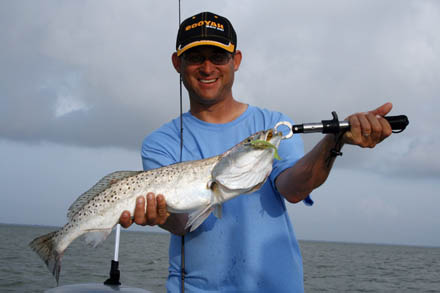 area. TIFT still
draws visitors to the area. In fact, over 1,500 anglers participate in the
event each August.
area. TIFT still
draws visitors to the area. In fact, over 1,500 anglers participate in the
event each August.
Located just across the Queen Isabella Memorial Bridge from Port Isabel is the relatively 'young' town of South Padre Island. Whereas Port Isabel is steeped in history, South Padre Island features all things modern. Schlitterbahn Beach Waterpark, one of the most technologically advanced parks of its kind, is the anchor of tourist activities on SPI and is situated on the island's southern end. Heading north along Padre Boulevard, South Padre's 'main drag,' visitors are treated to an impressive array of hotels, condominiums, restaurants, bars and souvenir shops.
For fishermen, there are just as many or more options once they get on the water. Like Port Mansfield to the north, the shallow grassflats between Port Isabel and South Padre Island yield plenty of impressive seatrout each year. In fact, the current state record fish (15.6 pounds) was taken by local fly fishermen Bud Rowland in 2002.
However, the biggest draw for anglers on the southern end of the Lower Laguna are the miles of shallow sand flats and, more specifically, the large schools of red drum that swim over them. Sight-casting for redfish is hands down the most popular activity on this side of the Lower Laguna.
Snook are another popular target on the south end of the Lower Laguna. These fish are available year around. From spring through fall, they can be taken on the shallow flats of the Lower Laguna and South Bay, a small body of water that lies between South Padre and Mexico. During the heat of summer, snook are thick in the Brazos Santiago Pass and along the beachfront.
Tarpon, too, are a big draw. While juvenile tarpon can be found year-around, the bigger fish show up in late spring and hang around until the first hard northerns work their way through the area usually late November or early December. The summer months also encourage kingfish, Spanish mackerel, bonito, ladyfish, jack crevalle and other species to move into the Brazos Santiago Pass, where they are easy targets for inshore anglers.
Without a doubt, the Lower Laguna Madre is one of the Gulf Coast's premier fisheries. For anglers heading to Deep South Texas for an angling vacation, it is simply a matter of choosing what type of shoreside amenities they want. Because, from a fishing point of view, it is impossible to go wrong with any area of the Lower Laguna during the summer months.
Getting There
For those looking to fly into South Texas, the Valley International Airport in Harlingen (www.flythevalley.com) is conveniently located close to both Port Mansfield and the Port Isabel/South Padre area. Some guides will arrange for airport pickup. Visitors heading to South Padre Island also have the option of an airport shuttle or, depending on which hotel they are staying at, a hotel shuttle service. Several taxis also run between VIA and Port Isabel and South Padre Island.
Those needing to rent a vehicle can do so at the airport. To get to Port Mansfield, the simplest way is to take US 77 North to Raymondville, then take 186 East. The road literally runs out in Port Mansfield. To drive to Port Isabel from VIA, take US 77 South to the Hwy 100/South Padre Island exit. Take Highway 100 East for approximately 23 miles and you'll be in Port Isabel. If you wish to continue to South Padre Island, simply continuing following Hwy 100 through Port Isabel, onto the Queen Isabella Memorial Bridge, and into South Padre.
Anglers driving down from points north of the Rio Grande Valley simply
need to take US 77 South until they hit Raymondville and 186 East to go
to Port Mansfield or until the come to the Hwy 100/South Padre Island exit
a few miles south of Harlingen in order to make it to PI/SPI. Take the applicable
exit and follow the road east until it runs out.


